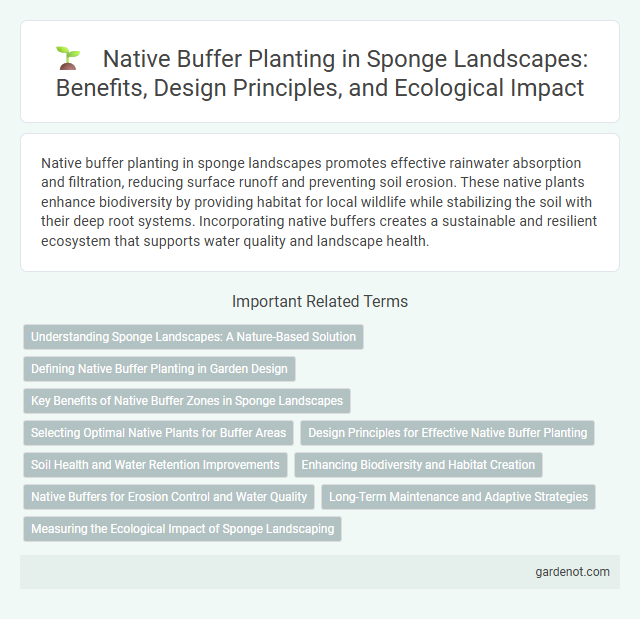Native buffer planting in sponge landscapes promotes effective rainwater absorption and filtration, reducing surface runoff and preventing soil erosion. These native plants enhance biodiversity by providing habitat for local wildlife while stabilizing the soil with their deep root systems. Incorporating native buffers creates a sustainable and resilient ecosystem that supports water quality and landscape health.
Understanding Sponge Landscapes: A Nature-Based Solution
Native buffer planting in sponge landscapes enhances water absorption and filtration by creating vegetative barriers that mimic natural ecosystems. These plants stabilize soil, reduce runoff, and increase groundwater recharge, effectively mitigating flooding and improving water quality. Implementing native species in buffer zones supports biodiversity while maintaining the functional integrity of sponge landscapes.
Defining Native Buffer Planting in Garden Design
Native buffer planting in garden design involves strategically arranging indigenous plants along the edges of landscapes or water bodies to enhance ecological function and water quality. These plant buffers act as natural filters, reducing erosion, absorbing pollutants, and providing critical habitat for local wildlife. Incorporating species like switchgrass, goldenrod, and native sedges optimizes soil retention and supports biodiversity within sponge landscape systems.
Key Benefits of Native Buffer Zones in Sponge Landscapes
Native buffer zones in sponge landscapes enhance water infiltration and reduce surface runoff, effectively controlling erosion and sedimentation. These vegetated areas support biodiversity by providing habitat for native flora and fauna, while improving groundwater recharge and water quality through natural filtration processes. Establishing native buffers contributes to resilient ecosystems by mitigating flood risks and maintaining hydrological balance within the sponge landscape.
Selecting Optimal Native Plants for Buffer Areas
Selecting optimal native plants for sponge landscape buffer areas involves prioritizing species with deep root systems that enhance soil stabilization and maximize water infiltration. Native grasses like Little Bluestem and Switchgrass improve sediment filtration while native shrubs such as Red Osier Dogwood and Buttonbush support biodiversity and provide effective pollutant uptake. Incorporating diverse native plants adapted to local climate conditions ensures resilient buffer zones that optimize stormwater management and ecological benefits.
Design Principles for Effective Native Buffer Planting
Effective native buffer planting in sponge landscapes relies on selecting diverse, deep-rooted native species that enhance soil infiltration and reduce surface runoff. Strategic layering of plants, from herbaceous groundcovers to shrubs and trees, maximizes water retention and promotes habitat biodiversity. Placement near water bodies follows contour lines to stabilize banks and filter pollutants before they enter aquatic systems.
Soil Health and Water Retention Improvements
Native buffer planting enhances soil health by increasing organic matter and promoting beneficial microbial activity, which improves nutrient cycling and soil structure. These deep-rooted native plants stabilize soil, reducing erosion and compaction while enhancing water infiltration and retention capacity. Improved soil moisture management supports resilient landscapes by maintaining hydration during dry periods and reducing surface runoff.
Enhancing Biodiversity and Habitat Creation
Native buffer planting plays a crucial role in sponge landscapes by enhancing biodiversity and creating essential habitats for local wildlife. These native plants stabilize soil, filter runoff, and provide food and shelter for insects, birds, and small mammals, fostering a balanced ecosystem. Integrating diverse native species into buffer zones supports ecological resilience and promotes long-term environmental health.
Native Buffers for Erosion Control and Water Quality
Native buffer planting plays a critical role in sponge landscape design by stabilizing soil and preventing erosion along waterways. Deep-rooted native plants enhance sediment retention and reduce nutrient runoff, significantly improving downstream water quality. Implementing diverse native buffers creates a resilient, natural filtration system that supports ecosystem health and mitigates flood impacts.
Long-Term Maintenance and Adaptive Strategies
Native buffer planting enhances sponge landscape resilience by promoting soil stabilization and water infiltration. Long-term maintenance focuses on periodic monitoring, invasive species control, and adaptive replanting to sustain biodiversity and ecosystem function. Adaptive strategies integrate climate-responsive species selection and dynamic management protocols to address changing environmental conditions effectively.
Measuring the Ecological Impact of Sponge Landscaping
Native buffer planting in sponge landscaping enhances stormwater absorption by promoting soil permeability and reducing surface runoff. Studies show that ecosystems with native buffers improve water quality by filtering pollutants and supporting local biodiversity. Measuring ecological impact involves monitoring parameters like infiltration rates, vegetation health, and changes in native species populations.
Native buffer planting Infographic

 gardenot.com
gardenot.com